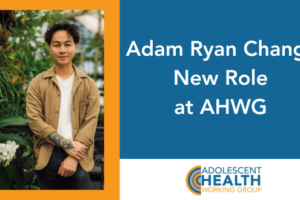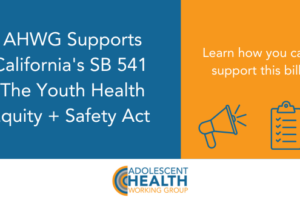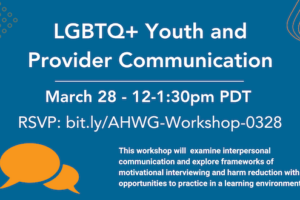
Disruptive Innovations – Unifying Strategies to Ending HIV/HCV/STI through a Whole-Person Care Model
Following our first collective impact and strategic planning meeting on November 21, 2019, the Adolescent Health Working Group (AHWG) reconvened community advocates, health practitioners, and youth experiencing homelessness for a second meeting on Thursday, December 19, 2019, to continue conversations on targeting funding to improve sexual, behavioral health, and overdose prevention services for youth who are unhoused. To bolster HIV/HCV/STI prevention and treatment for youth who are unsheltered, community advocates and youth stressed the need to further develop out a separate health-focused system of care for young people (including transitional-age youth).
This meeting was generously funded by the San Francisco Department of Public Health and hosted by the San Francisco (SF) LGBT Center with stakeholders from Glide, LYRIC, Homebase, SF Department of Public Health, Larkin Street Youth Services, SF LGBT Center, and San Francisco Community Health Center. Eight youth attended this meeting and actively participated in the collective impact process by sharing their experiences seeking care/navigating health clinics and housing services in San Francisco.
Two Community Access Points–Larkin Street and SF LGBT Center–were invited to present on a transgender housing program and the pilot of host homes in San Francisco. Representatives from Larkin Street shared insight on the “nation’s first long-term transitional living program specifically for transgender homeless young people,” which currently provides housing for six transgender youth and offers services such as case management, mental health counseling, and transition support. The SF LGBT Center provided an overview of its host homes project piloted six months ago in San Francisco to house young adults who are in need of transitional housing. The LGBT Center hopes that this pilot program can serve as a model for other cities in the bay area.
Our second meeting expanded on initially discussed services and ideas, including: (a) adapting existing sexual, behavioral health, overdose, and harm reduction resources to better train peer advocates, (b) providing increased mobile Hepatitis C and PreP services for certain districts to improve access to services and treatment, (c) empowering youth who are unsheltered to lead community discourse and equip them with skills to conduct more peer outreach, and (d) taking a holistic care approach to housing, employment, and residential care treatment programs with the intention of creating structural and systemic changes. Entwined in these topics were conversations on partnerships/collaborations with institutions in academia and the private sector.
In summary, increased funding would greatly improve on the availability of medical services onsite, as well as mobile van services, to make innovative health care services more accessible. This funding must also account for the shortage of existing health care staff as youth are being turned away (or told to return another day) when competing with other adult clients for services. Employing young people who are homeless in actual leadership roles with adequate compensation, and offering additional assistance with a rental subsidy, would be a model that has not been fully funded or implemented in our County’s history. We hope to continue to engage with community members to strategize and ultimately implement many of the ideas discussed.
For additional resources, some of the programs/projects mentioned that have done phenomenal work to serve youth experiencing homelessness include: Dance Safe, Drug Overdose Prevention & Education (DOPE), Second Chance, New Door Ventures, Year Up, HipHousing, Twitter & Compass Family Services Partner Program (NeighborhoodNest), and Huckleberry Youth Programs’ Cole Street Clinic.
Quotes from participants:
- “[The community] needs funding to get rid of scarcity and let everyone get access to the essential things they need without competing with other people.”
- “Let’s integrate holistic wellness, acupuncture, and more culturally competent resources and training development for youth and providers.”
- “We need to update housing or residential sites to provide equipment (e.g. tools, microwave, or instant pots) for youth to use in their apartments.”
- “We need a transitional-age youth navigation center.”
- “As we consider these services and strategies, we need to think about addressing systemic issues with systemic changes.”




